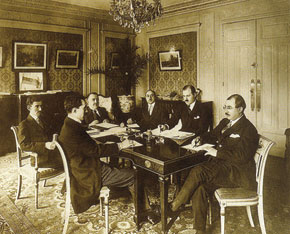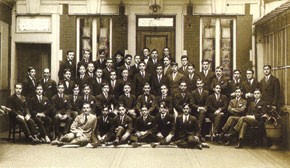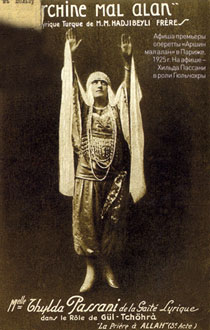Pages 50-54
by Ramiz Abutalibov
Emigration and exile are not easy tests for the human character. Some who leave their native land break down and suffer helplessly, some willingly give up their roots and memory and adapt successfully to the customs of their new environment, taking the more comfortable route, but others continue to hold on to the spirit and the image of their motherland, never losing sight of its gifts.
The people we will write about did not choose their lot, did not adapt or compromise their political outlook; they remained true to one guiding star, to a free and independent Azerbaijan, throughout their lives. Consequently for us their names personify forever the concepts of heroism and conscience within the terrible flow of events in the 20th century. They never spoke of themselves or their work in heroic or strident tones, such modest only makes their contribution to Azerbaijan’s history and political culture the more substantial.
Paris in the 1920s was second only to Istanbul as a centre for those Azerbaijanis who did not return home after the April revolution of 1920 carried out by Russian and Azerbaijani Bolsheviks. Removed from their country, but with spirit intact, they continued to struggle for a restoration of independence; they had, after all, committed themselves mind, body and soul to the triumph of the tricolour banner, temporarily hauled down. As with other émigrés, the Azerbaijanis in those years were a diverse ideological and social grouping. The only common factor was an aversion to Bolshevism and a desire for the sweeping change on the international political scene that they believed would crown their struggle with success and open up the road home.
The Paris Peace Conference 1919-20
Azerbaijani diplomats were the first enforced defectors. At the very moment the independent government of Azerbaijan was overthrown, the country’s diplomatic mission was participating in the work of the Paris Peace Conference. The mission’s composition had been confirmed by the Azerbaijani Parliament as follows: at its head, Alimardan bey Topchubashov (1862-1934); deputy leader Mammad Hasan Hajinsky (1875-1931); members of the mission Akbar Agha Sheykhulislamov (1891-1961) and Ahmed bey Aghayev (1869-1939) and counsellors Mammad Maharramov (1900-1982) and Jeyhun bey Hajibeyov (1891-1962). They were joined later by Abbas bey Atamalibeyov and Alfi Gafarov.
Upon arrival in the French capital, the mission submitted three memoranda to the Paris Peace conference: on the independence of Caucasian Azerbaijan, with a description of its borders and a map; on the economic and financial situation, with an economic layout; and on the ethnic make-up of the population of Azerbaijan, with diagrams and an ethnographic chart.
The Azerbaijani mission and its leader played a huge role in obtaining a unanimous de facto recognition of independent Azerbaijan, on 12 January 1920, by the Supreme Council of Allied Powers. This decision allowed the government of Azerbaijan to expand considerably the scope of its work on foreign policy. Unfortunately, the occupation of the country by the Bolsheviks on 28 April 1920 suspended the broad processes of recognition of the independence of the Azerbaijan Democratic Republic and made political émigrés of its diplomats. They were joined later by representatives of the intelligentsia, the military and the bourgeoisie who were abroad at that time and, after 1925, a majority of the Azerbaijani students studying in the countries of Western Europe and in Turkey.
Spreading the word
So the first wave of Azerbaijani emigration to France and other countries began to take shape. Naturally, colonies of Azerbaijanis emerged. The first association of Azerbaijani emigrants in Europe was created precisely in Paris, where there was already fertile ground. France’s first acquaintance with Azerbaijan was through works by the French orientalists Barbier de Meynard and Lucien Bouvat, as well as by the well-known writer George Sand, the works of the Polish orientalist Alexander Hodzko, who had lived in France, and also our compatriot Ahmed bey Aghaoglu, a graduate of the Sorbonne and the College de France (1888-1894). I found nine of Aghaoglu’s articles in French archives - they were published in the most prestigious French magazines - and one article published in English during the period between 15 March 1891 and 15 October 1893.
These first Azerbaijani diplomats in France were also very active in promoting their country during their official accreditation (May 1919 - April 1920). On 9 August 1919, the Paris prefecture registered the ‘France-Caucasus’ Committee, whose rules stated: “The committee is created for the purpose of assisting the development of economic relations between France and the Republics of Transcaucasia: Georgia and Azerbaijan”. The French diplomat and orientalist Edmond Hippeau was elected president of the committee, Prince Michael Sumbatoff from Georgia and Miryagub Mirmehdiyev from Azerbaijan (who was a member of the mission to the Paris Peace Conference) were elected vice-presidents. The mission also published the newsletter Azerbaijan until May 1920; Lucien Bouvat, mentioned above, was its editor. Altogether, 12 issues of the bulletin were published. In this short period a coloured map of Azerbaijan and three books in French were also published: The Caucasian Republic of Azerbaijan, The Economic and Financial Situation in Azerbaijan, and The Anthropological and Ethnic Structure of the Population of the Republic of Azerbaijan.
At the end of 1919, an article headed The First Muslim Republic by Jeyhun bey Hajibeyli, counsellor of the Azerbaijan mission, was published in the magazine ‘Revue du Monde Musulman’. The article reviewed the history, geography and economic development of Azerbaijan and was based on unique primary sources.
Performance and promotion
After the fall of the Azerbaijan Democratic Republic on 28 April 1920, Azerbaijani diplomats and businessmen in France created the Association of Azerbaijani Emigrants, headed by Alimardan bey Topchubashov. A students’ group was headed by D. Rahimov. A number of compatriots, including Abbas bey Atamaly, Farzi bey Vekilli, Aga Gasim Gasim-Zadeh, Zohra khanim Hajibeyli and Peri khanim Topchubashi, combined to produce the first performance in France of Uzeyir Hajibeyov’s social comedy Arshin Mal Alan. The comedy was translated by Jeyhun bey, the composer’s brother, and premiered at the Paris ‘Femina’ theatre on 4 July 1925.
Despite their difficult financial circumstances, the Azerbaijani emigrants continued to promote the history and culture of their native land. Doctor of Law Miryagub Mirmehdiyev published two books in French: Problems of the Caucasus and The Soviet Regime: Sources and Substance, and two books in Russian. A major article, A Glance at Azerbaijan Literature by the writer and former ambassador of Azerbaijan to Turkey, Yusif Vezir Chemenzeminli, was published in the ‘Revue du Monde Musulman’ in 1922. Also in the early twenties a short biography of the famous Azerbaijani journalist, Mahammad Aga Shahtakhtinsky was published in the world famous six-volume encyclopaedia Larousse du XXe siècle. The ‘Musavat’ party in Paris issued the first number of its magazine ‘Azerbaijan’ in October 1926. In 1930, the party’s chairman and leading light of Azerbaijani independence, Mammad Emin Rasulzade published two books: Azerbaijan’s Struggle for Independence, in French, and Panturanism in Respect of the Caucasus Problem in Russian. In 1933 Jeyhun bey Hajibeyli’s The Dialect and Folklore of Karabakh (Caucasian Azerbaijan) was issued in Paris. The lawyer Agha Gasim Gasimzade defended his doctoral thesis at the Sorbonne on the theme ‘The Bosporus and Dardanelles: legal aspects’.
The years went by; Europe and the rest of the world were undergoing the toughest of times. At the same time our diplomats, including Topchubashov, Hajibeyli and Mirmehdiyev, and businessmen like Asadullayev, Salimov and Hajinsky, as well as representatives of the second wave of emigration: G.Suleymanov, T.Taghiyev, M.Aliyev and others who joined them, were active in condemning the occupation of Azerbaijan by the Red Army. Thanks to their efforts, particularly to the efforts of Jeyhun bey Hajibeyli, Akbar Agha Sheykhulislamov and Abdurrahman Fatalibeyli, an Azerbaijani office was created in ‘Freedom’ radio, in Munich.
The Azerbaijani political emigrants supported Marshal Pilsudsky’s initiative to publish the monthly magazine ‘Prometheus’ in French in Paris. It was issued without a break from 1926 to 1939, inspiring the émigrés with its longevity. One of the main questions discussed on its pages was the formation of a Caucasian Confederation. Finally, on 14 July 1934, a pact to form a Confederation was signed in Brussels by the representatives of Azerbaijan (M.E.Rasul-Zadeh, A. M.Topchubashov), Georgia (N.Jordaniya, A.Chkhenkeli) and the North Caucasus (G.Sunsh, L.Chulik, T.Chakmak). Unfortunately, this idea had taken so long to mature, because of political ambitions and disagreements within the émigré circles, that by then the League of the Nations had recognised the USSR and its borders. So there was no influential political backing for an idea which thus became separatist.
The Second World War - resistance
The invasion of Poland by Nazi Germany in 1939 marked the next tragic stage for the first wave of émigrés, and a decline in their activity. However, after the collapse of Nazi Germany, the ranks of Azerbaijani exiles were replenished by captive former soldiers and officers of the Soviet army who did not wish to return to the USSR through fear of being condemned as traitors, irrespective of how they had been captured. There were also Azerbaijanis among the Soviet prisoners of war who joined the anti-fascists and participated in the resistance movements in France, Italy and Yugoslavia. Their contribution to the victory over fascism was recorded by decorations from the countries in which they fought.
Hitler’s regime was ruthless towards former Red Army men. In mid-August 1944 about 60 Azerbaijanis were shot by order of the German command in France.
I have had occasion to visit such French cities as Rodez and Montauban several times and met veterans of the Second World War René Shambar and Bernard Bonafus, in whose guerrilla bands our compatriots fought.
On 9 May 2005 these courageous people, who have not forgotten their Azerbaijani companions-in-arms, attended the unveiling of an obelisk in their memory at Rodez. The author of these lines was also afforded the great honour of participating in that solemn event. The memory of the first Azerbaijani political emigrants is maintained in France, which became their final resting place. There is a memorial plaque in the centre of Paris, at 37 rue Decamps, in the 16th arrondissement, where Alimardanbey Topchubashov lived, and the obelisk in memory of the Azerbaijanis mentioned above stands in the city of Rodez, in southwest France.
I was a witness when, on 19 December 1993, during his first visit to France, President of the Republic of Azerbaijan Heydar Aliyev honoured the memory of those first political exiles and laid wreaths on the tombs of the Topchubashov and Hajibeyli families. Azerbaijan does not forget her sons either. Today there are streets in Baku named after them.
… The essence of an issue is often revealed only in the fullness of time … We should remember this when we touch upon the activity of our political émigrés and the biographies of its most eminent representatives. These people always talk to us. It is simply necessary to listen…
About the author: Ramiz Abutalibov worked at the UNESCO secretariat (Paris, 1971-1979) and was head of administration (1985-1992). He was ambassador on special missions for the Ministry of Foreign Affairs of the Republic of Azerbaijan (1993-2004). He was awarded the “Legion of Honour”. He has studied the history of Azerbaijani emigration, especially the lives and work of emigrants to France. He is also the author of books and articles on the history and topical problems of modern social and political life in Azerbaijan, published in France, Great Britain, Germany, Russia and other countries.
by Ramiz Abutalibov
Emigration and exile are not easy tests for the human character. Some who leave their native land break down and suffer helplessly, some willingly give up their roots and memory and adapt successfully to the customs of their new environment, taking the more comfortable route, but others continue to hold on to the spirit and the image of their motherland, never losing sight of its gifts.
The people we will write about did not choose their lot, did not adapt or compromise their political outlook; they remained true to one guiding star, to a free and independent Azerbaijan, throughout their lives. Consequently for us their names personify forever the concepts of heroism and conscience within the terrible flow of events in the 20th century. They never spoke of themselves or their work in heroic or strident tones, such modest only makes their contribution to Azerbaijan’s history and political culture the more substantial.
Paris in the 1920s was second only to Istanbul as a centre for those Azerbaijanis who did not return home after the April revolution of 1920 carried out by Russian and Azerbaijani Bolsheviks. Removed from their country, but with spirit intact, they continued to struggle for a restoration of independence; they had, after all, committed themselves mind, body and soul to the triumph of the tricolour banner, temporarily hauled down. As with other émigrés, the Azerbaijanis in those years were a diverse ideological and social grouping. The only common factor was an aversion to Bolshevism and a desire for the sweeping change on the international political scene that they believed would crown their struggle with success and open up the road home.
The Paris Peace Conference 1919-20
Azerbaijani diplomats were the first enforced defectors. At the very moment the independent government of Azerbaijan was overthrown, the country’s diplomatic mission was participating in the work of the Paris Peace Conference. The mission’s composition had been confirmed by the Azerbaijani Parliament as follows: at its head, Alimardan bey Topchubashov (1862-1934); deputy leader Mammad Hasan Hajinsky (1875-1931); members of the mission Akbar Agha Sheykhulislamov (1891-1961) and Ahmed bey Aghayev (1869-1939) and counsellors Mammad Maharramov (1900-1982) and Jeyhun bey Hajibeyov (1891-1962). They were joined later by Abbas bey Atamalibeyov and Alfi Gafarov.
Upon arrival in the French capital, the mission submitted three memoranda to the Paris Peace conference: on the independence of Caucasian Azerbaijan, with a description of its borders and a map; on the economic and financial situation, with an economic layout; and on the ethnic make-up of the population of Azerbaijan, with diagrams and an ethnographic chart.
The Azerbaijani mission and its leader played a huge role in obtaining a unanimous de facto recognition of independent Azerbaijan, on 12 January 1920, by the Supreme Council of Allied Powers. This decision allowed the government of Azerbaijan to expand considerably the scope of its work on foreign policy. Unfortunately, the occupation of the country by the Bolsheviks on 28 April 1920 suspended the broad processes of recognition of the independence of the Azerbaijan Democratic Republic and made political émigrés of its diplomats. They were joined later by representatives of the intelligentsia, the military and the bourgeoisie who were abroad at that time and, after 1925, a majority of the Azerbaijani students studying in the countries of Western Europe and in Turkey.
Spreading the word
So the first wave of Azerbaijani emigration to France and other countries began to take shape. Naturally, colonies of Azerbaijanis emerged. The first association of Azerbaijani emigrants in Europe was created precisely in Paris, where there was already fertile ground. France’s first acquaintance with Azerbaijan was through works by the French orientalists Barbier de Meynard and Lucien Bouvat, as well as by the well-known writer George Sand, the works of the Polish orientalist Alexander Hodzko, who had lived in France, and also our compatriot Ahmed bey Aghaoglu, a graduate of the Sorbonne and the College de France (1888-1894). I found nine of Aghaoglu’s articles in French archives - they were published in the most prestigious French magazines - and one article published in English during the period between 15 March 1891 and 15 October 1893.
These first Azerbaijani diplomats in France were also very active in promoting their country during their official accreditation (May 1919 - April 1920). On 9 August 1919, the Paris prefecture registered the ‘France-Caucasus’ Committee, whose rules stated: “The committee is created for the purpose of assisting the development of economic relations between France and the Republics of Transcaucasia: Georgia and Azerbaijan”. The French diplomat and orientalist Edmond Hippeau was elected president of the committee, Prince Michael Sumbatoff from Georgia and Miryagub Mirmehdiyev from Azerbaijan (who was a member of the mission to the Paris Peace Conference) were elected vice-presidents. The mission also published the newsletter Azerbaijan until May 1920; Lucien Bouvat, mentioned above, was its editor. Altogether, 12 issues of the bulletin were published. In this short period a coloured map of Azerbaijan and three books in French were also published: The Caucasian Republic of Azerbaijan, The Economic and Financial Situation in Azerbaijan, and The Anthropological and Ethnic Structure of the Population of the Republic of Azerbaijan.
At the end of 1919, an article headed The First Muslim Republic by Jeyhun bey Hajibeyli, counsellor of the Azerbaijan mission, was published in the magazine ‘Revue du Monde Musulman’. The article reviewed the history, geography and economic development of Azerbaijan and was based on unique primary sources.
Performance and promotion
After the fall of the Azerbaijan Democratic Republic on 28 April 1920, Azerbaijani diplomats and businessmen in France created the Association of Azerbaijani Emigrants, headed by Alimardan bey Topchubashov. A students’ group was headed by D. Rahimov. A number of compatriots, including Abbas bey Atamaly, Farzi bey Vekilli, Aga Gasim Gasim-Zadeh, Zohra khanim Hajibeyli and Peri khanim Topchubashi, combined to produce the first performance in France of Uzeyir Hajibeyov’s social comedy Arshin Mal Alan. The comedy was translated by Jeyhun bey, the composer’s brother, and premiered at the Paris ‘Femina’ theatre on 4 July 1925.
Despite their difficult financial circumstances, the Azerbaijani emigrants continued to promote the history and culture of their native land. Doctor of Law Miryagub Mirmehdiyev published two books in French: Problems of the Caucasus and The Soviet Regime: Sources and Substance, and two books in Russian. A major article, A Glance at Azerbaijan Literature by the writer and former ambassador of Azerbaijan to Turkey, Yusif Vezir Chemenzeminli, was published in the ‘Revue du Monde Musulman’ in 1922. Also in the early twenties a short biography of the famous Azerbaijani journalist, Mahammad Aga Shahtakhtinsky was published in the world famous six-volume encyclopaedia Larousse du XXe siècle. The ‘Musavat’ party in Paris issued the first number of its magazine ‘Azerbaijan’ in October 1926. In 1930, the party’s chairman and leading light of Azerbaijani independence, Mammad Emin Rasulzade published two books: Azerbaijan’s Struggle for Independence, in French, and Panturanism in Respect of the Caucasus Problem in Russian. In 1933 Jeyhun bey Hajibeyli’s The Dialect and Folklore of Karabakh (Caucasian Azerbaijan) was issued in Paris. The lawyer Agha Gasim Gasimzade defended his doctoral thesis at the Sorbonne on the theme ‘The Bosporus and Dardanelles: legal aspects’.
The years went by; Europe and the rest of the world were undergoing the toughest of times. At the same time our diplomats, including Topchubashov, Hajibeyli and Mirmehdiyev, and businessmen like Asadullayev, Salimov and Hajinsky, as well as representatives of the second wave of emigration: G.Suleymanov, T.Taghiyev, M.Aliyev and others who joined them, were active in condemning the occupation of Azerbaijan by the Red Army. Thanks to their efforts, particularly to the efforts of Jeyhun bey Hajibeyli, Akbar Agha Sheykhulislamov and Abdurrahman Fatalibeyli, an Azerbaijani office was created in ‘Freedom’ radio, in Munich.
The Azerbaijani political emigrants supported Marshal Pilsudsky’s initiative to publish the monthly magazine ‘Prometheus’ in French in Paris. It was issued without a break from 1926 to 1939, inspiring the émigrés with its longevity. One of the main questions discussed on its pages was the formation of a Caucasian Confederation. Finally, on 14 July 1934, a pact to form a Confederation was signed in Brussels by the representatives of Azerbaijan (M.E.Rasul-Zadeh, A. M.Topchubashov), Georgia (N.Jordaniya, A.Chkhenkeli) and the North Caucasus (G.Sunsh, L.Chulik, T.Chakmak). Unfortunately, this idea had taken so long to mature, because of political ambitions and disagreements within the émigré circles, that by then the League of the Nations had recognised the USSR and its borders. So there was no influential political backing for an idea which thus became separatist.
The Second World War - resistance
The invasion of Poland by Nazi Germany in 1939 marked the next tragic stage for the first wave of émigrés, and a decline in their activity. However, after the collapse of Nazi Germany, the ranks of Azerbaijani exiles were replenished by captive former soldiers and officers of the Soviet army who did not wish to return to the USSR through fear of being condemned as traitors, irrespective of how they had been captured. There were also Azerbaijanis among the Soviet prisoners of war who joined the anti-fascists and participated in the resistance movements in France, Italy and Yugoslavia. Their contribution to the victory over fascism was recorded by decorations from the countries in which they fought.
Hitler’s regime was ruthless towards former Red Army men. In mid-August 1944 about 60 Azerbaijanis were shot by order of the German command in France.
I have had occasion to visit such French cities as Rodez and Montauban several times and met veterans of the Second World War René Shambar and Bernard Bonafus, in whose guerrilla bands our compatriots fought.
On 9 May 2005 these courageous people, who have not forgotten their Azerbaijani companions-in-arms, attended the unveiling of an obelisk in their memory at Rodez. The author of these lines was also afforded the great honour of participating in that solemn event. The memory of the first Azerbaijani political emigrants is maintained in France, which became their final resting place. There is a memorial plaque in the centre of Paris, at 37 rue Decamps, in the 16th arrondissement, where Alimardanbey Topchubashov lived, and the obelisk in memory of the Azerbaijanis mentioned above stands in the city of Rodez, in southwest France.
I was a witness when, on 19 December 1993, during his first visit to France, President of the Republic of Azerbaijan Heydar Aliyev honoured the memory of those first political exiles and laid wreaths on the tombs of the Topchubashov and Hajibeyli families. Azerbaijan does not forget her sons either. Today there are streets in Baku named after them.
… The essence of an issue is often revealed only in the fullness of time … We should remember this when we touch upon the activity of our political émigrés and the biographies of its most eminent representatives. These people always talk to us. It is simply necessary to listen…
About the author: Ramiz Abutalibov worked at the UNESCO secretariat (Paris, 1971-1979) and was head of administration (1985-1992). He was ambassador on special missions for the Ministry of Foreign Affairs of the Republic of Azerbaijan (1993-2004). He was awarded the “Legion of Honour”. He has studied the history of Azerbaijani emigration, especially the lives and work of emigrants to France. He is also the author of books and articles on the history and topical problems of modern social and political life in Azerbaijan, published in France, Great Britain, Germany, Russia and other countries.






